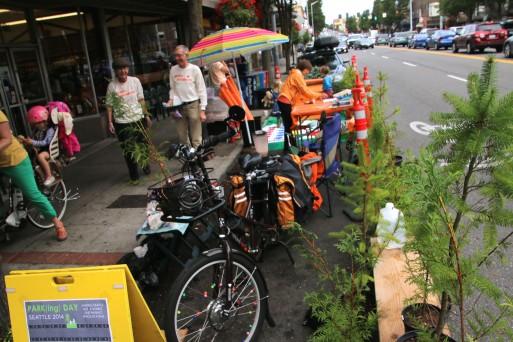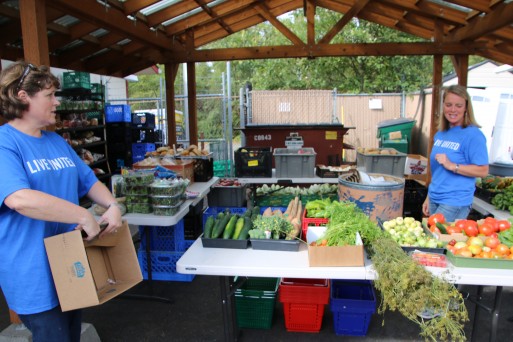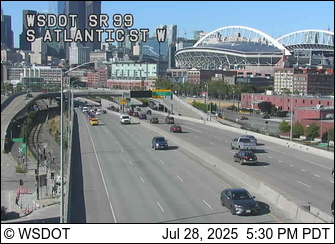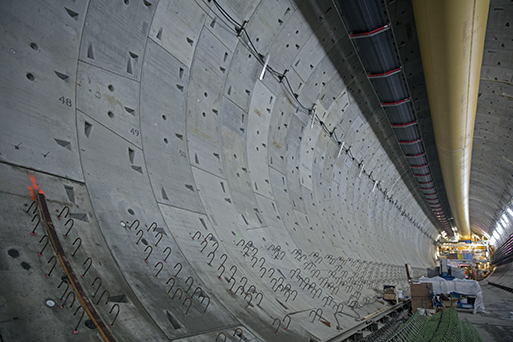West Seattle, Washington
19 Friday

It’s been six years in the making, but the “Fauntleroy Boulevard” plan is still in the “early design” phase – which is why, if you are interested in the future of Fauntleroy Way between the bridge and SW Alaska, you’re going to want to go to next Tuesday’s community meeting.
SDOT’s Fauntleroy Boulevard Project manager Therese Casper and consultant Mike Hendrix (from Perteet) came to this week’s Junction Neighborhood Organization meeting for one last community-council-level briefing before that meeting, which, by the way, will be in open-house format, so don’t worry if you can’t get there right when it starts at 5 pm – drop in for a look at the plans any time before 7 pm.
We’ve written about it before – going back to 2008 – and Casper noted that its origins go back even further, to the West Seattle Junction Plan of 1999, and now the Bicycle Master Plan‘s goals have been folded in, designating this as an area for protected bicycle lanes, as well as the “community needs” in the Triangle Streetscape Plan, and enhancement of Fauntleroy Way’s role as a gateway to West Seattle.
The Fauntleroy Boulevard plan has reached 30 percent design, and has funding through 60 percent design. The city budget process that kicks into high gear next week, with Mayor Murray presenting his proposal on Monday afternoon, will determine what happens next – will there be money to finish the design and build the project?
Its typical cross-section is the same one we first showed in July: 6′ sidewalks, 6′ protected bike lanes (asphalt), landscape strip, outside lanes of roadway maintained at 12′ (to facilitate freight needs), 10’ travel lane inside, then middle turn lane OR planted median. You can see it and the block-by-block concept on this info-sheet, also from July:
Here’s the latest on some key points – with many more details promised at next Tuesday’s open house:
Announced late today by SDOT, more repair work is ahead for the surface of the Spokane Street Viaduct. Next Thursday (September 25th), the inside (left) eastbound lane will be closed 10 am-2 pm to fix “spalls” between the Highway 99 overpass and the 4th Avenue exit.

(First two photos by WSB’s Patrick Sand)
3:44 PM: Police and fire are responding to a report of a man shot in the leg near 30th SW and High Point Drive SW. Officers are with him and SFD medics are arriving. Updates to come.

3:57 PM: The victim is an 18-year-old man described as having a small-caliber-handgun wound through the back of his calf. He’s on the way to the hospital. No arrest reported yet. According to our crews on the scene, it’s actually in the southeast part of High Point, near the 30th/Sylvan area where Forest Lawn has its headquarters building.
4:12 PM: Via SPD Blotter, here’s what police are saying:
Officers began receiving calls just after 3:30 p.m. Friday of a fight involving up to 20 people in the 3000 block of High Point Way SW. Officers rushed to the scene and found an 18-year-old that had been shot in the leg. Witnesses pointed officers towards a group of people who had made their way through a cemetery and disappeared. … Officers continue to scour the area looking for the suspect in this case. The only description provided of the shooter is a black male, 5-foot-8, 150 pounds wearing a red shirt. Officers are asking anyone who spots the suspect to call 911 immediately.
According to radio communication, police believe they have found the (or a) gun in the area.

(This photo and next by WSB’s Christopher Boffoli)
5:21 PM UPDATE: Still no word of an arrest. The aforementioned gun can be seen in the photo above, under a car. Though only one victim has been confirmed at this point, multiple shots were fired, indicated by the markers:

Before you move entirely into weekend mode, early reminders about two ways you can start your weekend in grand community-contribution style, both happening Saturday morning:
ALKI CLEANUP: Join Puget SoundKeeper Alliance and friends on International Coastal Cleanup Day. Check in by Statue of Liberty Plaza (61st/Alki) at 8:45 on Saturday, clean the beach 9 am-noon. Full details here.
PARKING LOT PARTY: The big lot at the Boren Building (5950 Delridge Way SW) is now used by two schools, with Arbor Heights Elementary joining K-5 STEM these next two years. They could use some community help with safety upgrades and cleanup 8 am-noon Saturday: “Projects include painting, unearthing a hidden sidewalk, adding new signage, and beautifying the grounds. We’ve got the supplies & tools – we just need your help to make it happen!”
After all that, TONS more ways to enjoy your Saturday – preview them on our calendar.
Around the city, 50+ parking spaces have become parklets for a few hours, including 2 in West Seattle, continuing until 3 pm:

That’s Sona and her mom in the PARKing Day parklet by Wyatt’s Jewelers (WSB sponsor) in Westwood Village, second year that Wyatt’s has set one up with games to play and a place to sit.
Amber, a citywide PARKing Day organizer who has been making the rounds, tweeted the photo of the West Seattle Bike Connections parklet in front of Mashiko and Husky Deli in The Junction, in full swing with bike-powered milkshakes among other attractions:
Milkshakes and games at West Seattle Bike's pop-up park! #parkingday #SDF2014 pic.twitter.com/ZBmQnIR4An
— Amber Raynsford (@ambervarie) September 19, 2014
We’re stopping by there shortly and should have a pic to add. Both are up and running until 3 pm, as are almost 50 others citywide. Even if you’re off-peninsula – check the map; might be one near you.
ADDED 1:56 PM: Our photo overlooking the parklet in The Junction:

As noted in our daily preview, Michael Oxman brought the greenery. Go test the bike-powered blender!

The historic, now-community-owned Fauntleroy Schoolhouse is one of more than 500 sites around King County getting free TLC today during the United Way of King County “Day of Caring” event. Companies from around the region have sent more than 11,000 workers to volunteer – like the people from Car Toys who were busy around the schoolhouse’s grounds, including Fauntleroy Children’s Center.

We got there just in time to say hi to UWKC’s CEO Jon Fine, who chose it as his first stop on a tour of several volunteer projects.

Another local site getting Day of Caring help, the White Center Food Bank:

“Day of Caring” volunteers there (including Sally and Lynda in our photo) are from Bentall Kennedy. WCFB is just four weeks away from its big annual fundraising Harvest Dinner/Auction, by the way (October 18th at SSC’s Brockey Center), and you can still get tickets by going here.
ADDED 5:55 PM: The Kenney (WSB sponsor) shares the photo of “Day of Caring” volunteers from Microsoft:

40 Microsoft employees in all worked on landscaping around The Kenney’s campus, donating more than 175 hours of work in all.

(West Seattle Bike Connections‘ PARKing Day parklet in The Junction, photo by Michael Oxman, who donated the trees)
From the WSB West Seattle Event Calendar, for your Friday morning/afternoon/evening:
PARKing DAY: Two parklets in West Seattle, until 3 pm – The Junction (top photo) and Westwood Village – detailed in our preview. We’ll be visiting them later this morning. and two of the 50 temporary in-the-street mini-parks in the city will be in West Seattle, one in front of Husky Deli and Mashiko in The Junction, one in front of Wyatt’s Jewelers (WSB sponsor) in Westwood Village, both 9 am-3 pm. See the citywide map here.
MOPS REGISTRATION PLAYDATE: Returning member of MOPS (Mothers Of Pre-Schoolers) or interested in joining? 10:30 am registration playdate today at Ercolini Park – details in our calendar listing. (48th/Alaska)
CHAT WITH CHAS: Another coffee chat with Chas Redmond, the only candidate actively campaigning so far for the West Seattle/South Park district City Council seat on next year’s ballot (David Ishii also has filed), 11 am-1 pm at Pearls Tea and Coffee in North Delridge – informal drop-in. (4800 Delridge Way SW)
FILL THE BOOT: 1-6 pm, be on the lookout again for local firefighters helping collect donations for MDA’s fight against muscle disease, various locations.
FINAL FRIDAY FARMSTAND: 4:30-7:30 pm, one last time to buy farm-fresh produce on Delridge in a stand set up by volunteers working with the future Delridge Grocery co-op. (5435 Delridge Way SW)
‘DOG DAYS OF SUMMER’ CONTINUE: Fifth of six chances for your dog(s) to swim in the closed-to-humans-until-next-year Arbor Heights Swim and Tennis Club pool. It’s a fundraiser for youth at the club; details here. Today’s session is 5-7 pm. (11003 31st SW)
WESTFEST, NIGHT 1: Holy Rosary School‘s annual festival begins, 6-10 pm at the campus in The Junction. Details and entertainment schedule, in our preview. (42nd/Genesee)
STORIES FROM THE UKRAINIAN COMMUNITY: Trusted Advocates’ cultural-storytelling event features stories of Ukraine with Oleg Pynda. 6:30 pm at Seola Gardens. (11215 5th SW)
FREE MOVIE NIGHT AT HPIC: Doors at 6:30, movie at 7 at Highland Park Improvement Club – see our calendar listing for the movie hint and other details. (12th/Holden)
‘THE MOUNTAINTOP’: 7:30 pm at ArtsWest (WSB sponsor), the Northwest premiere of “The Mountaintop” continues, directed by Valerie Curtis-Newton. Buy your ticket(s) online, here. (4711 California SW)
‘BREAK OF NOON’ AT YOUNGSTOWN: ReAct Theatre presents the recent Broadway hit at Youngstown Cultural Arts Center, 8 pm – details in our calendar listing. (4408 Delridge Way SW)
HIGH-SCHOOL FOOTBALL: Chief Sealth International High School is home tonight, at SW Athletic Complex, 7 pm, hosting Nathan Hale; West Seattle High School is on the road vs. Garfield at Memorial Stadium downtown, 5 pm.
NIGHTLIFE: Lots of live music, karaoke, and more – browse the listings on our calendar page!



(WS bridge and Highway 99 views; more cams on the WSB Traffic page)
We’re headed into the last weekend of what’s still technically summer.
PARKing DAY TODAY: As we’ve been reporting, it’s PARKing Day, and two of the 50 temporary in-the-street mini-parks in the city will be in West Seattle, one in front of Husky Deli and Mashiko in The Junction, one in front of Wyatt’s Jewelers (WSB sponsor) in Westwood Village, both 9 am-3 pm. See the citywide map here.
CITYWIDE WEEKEND ALERTS: From the Susan G. Komen 3-Day leaving Memorial Stadium downtown early this morning (good luck, everybody!) to the Seahawks game on Sunday, citywide notes are in this roundup from SDOT.
TRANSPORTATION NEWS: Published here since the last traffic watch – Transportation triple bill @ Delridge District Council … WSB’s Christopher Boffoli on the tunnel tour … Murray CSO excavation followup – where IS all that dirt being taken (etc.)?
(EDITOR’S NOTE: Even if you agree with the advocacy group that has declared the Highway 99 tunnel a “boondoggle,” nine months after its boring machine stalled, you might be interested in a look at what’s already been done and what’s continuing to progress even before the upcoming repairs. WSDOT invited media to tour the site Thursday, and photojournalist Christopher Boffoli went on behalf of WSB. Here are his photos and narrative of how it went.

Photos, video, and story by Christopher Boffoli
Reporting for West Seattle Blog
The meeting point for our tour was an entrance at the end of South King Street just under the Alaskan Way Viaduct. After being issued safety clothes (hard hat, safety glasses, gloves, and reflective vests) we were greeted by Chris Dixon, Project Manager for Seattle Tunnel Partners, who led our group of about 7 or 8 journalists over to one of the engineering and orientation trailers.
This was a small meeting room with a lot of colorful schematics and cross-section geologic diagrams on the walls:

Dixon explained that – while the Tunnel Boring Machine (TBM) is idle – work is advancing at both the north end of the site (where a cut and cover tunnel is being prepared in the area where the TBM will eventually emerge) and the south end of the site, near the stadiums, where the future roadways are being prepared.
There is also a great deal of activity inside the existing tunnel itself. On a whiteboard Dixon drew a cross-section of the tunnel and explained how crews are busy installing structures called corbels along the tunnel floor:

These concrete structures are essentially footings that will bear the weight of the straight interior tunnel walls and the concrete road decks (southbound traffic above and northbound traffic below) that vehicles will drive over.
He said that by the time the TBM resumes its digging, they expect to have 450 feet of the tunnel’s interior complete. Dixon said that this work was originally set to happen later but that they have reconfigured the schedule while work is underway to repair the TBM.
We were joined by Matt Preedy, Deputy Program Administrator, WSDOT (and a West Seattle resident).
All of the journalists were issued numbered brass tags which were recorded on a ledger and that we pinned to our vests. As we left the engineering trailer and entered the site, there were a number of large boards with numbered dots painted on them. Dixon and Preedy went to the boards and attached their own brass tags to them.

They didn’t take the time to explain, but those ‘pit tags’ (also called check tags) are a system employed for hundreds of years to keep track of who is working inside a mine, or in this case, a tunnel. One of the first things we saw (at ground level) were piles of curved, pre-cast concrete panels that are arranged in place behind the TBM.

Bolted together into rings, they form the very strong, outer tunnel walls. Their tight-fitting gaskets are designed to keep ground water at bay.

There are ten panels in each ring and there are to be 1,450 rings in the complete tunnel.
We walked out over a concrete gantry from which we could look down on the launch pit below. To the south were the almost completed roadways that someday would carry traffic in and out of the SR-99 tunnel:

Turning around, we could see the entirety of the launch pit and the tunnel entrance at the end of it.

We descended about eight flights of steep, metal stairs to the floor of the site.

Behind us (to the south) was a completed section of cut-and-cover tunnel, with its neat, square walls, unlike the circular structure of the bored tunnel that we were about to tour.

Construction material (mostly rebar) was everywhere:

Along the sides of the pit, workers were busy covering the walls with Spray-Crete, a light, liquid form of cement.

To our right we could see the below-ground part of what we were told would become the South Operation Building. Water also seemed to be ubiquitous, seeping in all over the walls of the site.

Dixon said that, though some of it might be from nearby Elliott Bay, most of it was fresh groundwater.
We descended a ladder to an even lower section of the launch pit, level with the bottom of the tunnel.

Walking inside the tunnel at last, we could see large red concrete forms and workers installing structural re-bar along the bottom sides of the tunnel.

This is the corbel work we were told about.

Beyond the equipment and activity near the entrance of the tunnel, it was only when you walked a bit further into the tunnel that could you appreciate the impressive size of the space.

It was here that you could also appreciate the intricate puzzle of curved concrete panels.

Overhead was a large yellow ventilation shaft that brings fresh air into the deepest part of the tunnel and that can be reversed in an emergency to pull smoke from a fire out of the tunnel. Also above was part of the long conveyor belt on which tailings and slurry are removed to awaiting barges. Dixon explained that, as the TBM advances, sections of conveyor belt are added.

By the end of the project, the belt will be as long as the tunnel itself.

Outside in the open pit we had seen piles of coiled belt sections waiting to be installed in the future.
The first part of the TBM you see is the white-painted, rear superstructure of the
300 foot long trailing section.

Massive wheels support the entire machine, which includes all of the systems of wires and pipes for power and to pump chemicals and grout towards the face of the TBM. As you move forward, you encounter the system that receives the curved panel sections, picks them up, orients them to the proper position and location for installation when they are needed.

Moving forward still, you approach the section of the TBM that is behind the cutting face.

Everything there seems covered with some form of water or mud. There are hazards to footing and low clearances, making it a challenge to decide if you should watch your head or where you step. Everything was lit with fluorescent tubes, giving it a bright – if slightly green – cast. As we arrived to the most recently-installed ring of curved concrete sections, at the very bottom, Dixon and Preedy showed us the enormous pistons that the TBM uses to push against the edge of the course of concrete rings to advance itself forward.

As politicized as the bored tunnel has been and continues to be in Seattle, I must say that standing in the bowels of the machine, it is difficult not to be in awe of the scale and size of the complex machinery, the intricate tapestry of conduits, hoses, pistons, motors, fittings and beams – the sheer audacity of the technology involved in pushing through the earth blindly at 100 feet below sea level.

It is a level of technological complexity that I have only before seen when watching a Ridley Scott film set inside of a spaceship. It did not seem like a place that a group of human beings should be standing. And it was even more incomprehensible that people had designed and built it.
We climbed narrow staircases through a maze of passageways to see where the muddy tailings from the cutting face begin their journey out of the tunnel.

On another level we visited the control room with the screens and consoles from which workers can manage and monitor all aspects of the TBM when it is in operation.

Dixon explained that the numbers we saw on the primary displays indicated just over two bars of pressure (regular atmospheric pressure is one bar; most commercial espresso makers operate at 10-15 bars of pressure). Even though the TBM was not running he said that the instruments generally don’t read much more than that. He added that – when in operation – the cutting face of the TBM isn’t even all that loud, though Preedy added that all of the motors that power the conveyor belts for the removal of tailings do make the back of the machine very noisy.
Though the TBM was idle, Dixon said that workers are kept busy “exercising” and maintaining many of the parts of the machine that might atrophy or otherwise fall into disrepair if left sitting for a long time. It wasn’t uncomfortably warm inside the heart of the machine, though Dixon said that when the TBM is in operation it does get quite hot down there as the heat of friction is transferred through the cutting face to the surrounding spaces. Heat played into what went wrong, and what’s being fixed, he explained:
Adjacent to the control room – still inside the heart of the TBM structure – was a break room that, with coffee maker, microwave oven, long lunch tables, etc. would look at home in any factory. It was hard to believe it was at the center of an incredibly complex machine deep underground.
Nearby we saw a collection of cutting heads, each weighing 1500 pounds, that could be attached to an overhead rail for transport to the front of the cutting face for replacement. Various cutting heads are used, depending on the soil conditions.

The “rippers” we saw are best suited for the type of loose glacial soils that are expected in this section of the project.
At the very front of the TBM we could see the large blue motors that individually power each of the cutting heads.

On the same level we could see the central drive shaft, painted light green. And to the sides were large pressure vessels through which men and equipment could safely transition to the pressurized area on the other side of the cutting face, if needed.

With our tour complete we walked back through the various stairways and passages, back down to the tunnel floor at the rear of the TBM’s trailing gear, and out the way we came.

The palms of my light-colored gloves – which had honestly seemed like overkill at the start of the tour – had somehow become darkened.

After we had climbed the fairly treacherous ladders and countless treads of metal stairways, we were led back to the engineering and orientation trailers where, one by one, we turned in our numbered brass tags and were signed out of the ledger.

What happens next in the repair process? Here’s the latest update on the project website. For more on the project’s status, here’s what our partners at The Seattle Times published post-tour.
| 12 COMMENTS